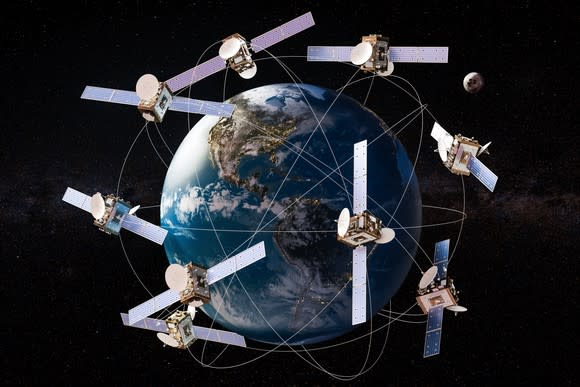Selling Maxar Stock? You Could Be Making a Huge Mistake
By now you've heard the news: One of Maxar Technologies' (NYSE: MAXR) satellites is dying.
Specifically, Maxar's WorldView-4 digital imaging satellite, the one previously known as GeoEye-2 back before DigitalGlobe bought GeoEye... and before Maxar bought DigitalGlobe. (Can you tell there's been a lot of M&A going on in space?)
With its gyros on the fritz, Maxar fears WorldView-4 may never snap another good shot of Earth again, and the company might have to write off the satellite entirely. When that news broke back on Jan. 7, it prompted an immediate sell-off in the stock. In the 14 days since, Maxar Technologies shares have lost an incredible 57% of their worth.
Clearly, investors had a negative reaction to Maxar's news. But was it an overreaction? Let's crunch some numbers and find out.

Maxar's spending heavily to replace a few big satellites with lots of little ones. Image source: Getty Images.
Damage report
Maxar's sell-off earlier this month was big news, but in fact, Maxar stock has been sinking for some time now -- down more than 90% over the past year. The good news about this is that, at a market capitalization of less than $300 million, Maxar stock now appears enticingly cheap.
Consider: Next year, S&P Global Market Intelligence estimates that Maxar could earn as much as $117 million, which means that Maxar stock currently costs less than three times forward earnings. Moreover, Maxar is currently paying its shareholders a dividend yield of 21.7%.
Between the cheap valuation and the rich dividend yield, the case for buying Maxar stock looks pretty strong. Unfortunately, there are caveats to this story that complicate the case for owning Maxar.
Caveats abound
Free cash flow, for example. From the perspective of trailing results, Maxar looks like a cash machine. Although the company's trailing earnings are currently negative, Maxar nonetheless generated positive cash profits (cash from operations, minus capital spending) of $286 million over the past 12 months. That's nearly as much as Maxar's own market cap, currently, and seems like another great argument for buying the stock.
But again -- not so fast.
Last quarter, Maxar updated investors on its capital spending plans for fiscal 2018, advising that through the end of last year, it planned to spend between $300 million and $315 million on capital improvements (mainly for a new satellite constellation dubbed "WorldView Legion"). Now, through the end of the third quarter, Maxar had spent only about one-third this amount -- $115 million. That means that when Q4 results come out, we should see a sharp spike in spending. Maxar probably spent twice as much in Q4 as it spent in the three prior quarters combined.
Such a rapid uptick in capital expenditures will, of course, eat deeply into Maxar's free cash flow. But even so, and even assuming Maxar spent the full $315 million last year, that would seem to leave the company with more than $100 million in 2018 free cash flow -- and a valuation of three times free cash flow.
In other words: still looks cheap.
2019 and beyond
Of course, all of these calculations are predicated on the assumption that 2019, 2020, and so on for Maxar will look a lot like 2018, but this might not be the case.
For example, losing WorldView-4 could cost Maxar as much as $85 million in lost revenue annually from 2019 on. Granted, that's only about 4% of what Maxar takes in in a year, but it will still eat into free cash flow.
The good news here is that last month, Maxar reassured investors that the spike in capex that began in Q4 2018 and will probably run through 2019 will abate in 2020. Maxar's heavy capital spending program, you see, is needed to build the WorldView Legion constellation of small satellites to replace Maxar's older, bigger WorldView-1, GeoEye-1, and WorldView-2 satellites (and now, probably, its defunct WorldView-4 as well).
That sounds like a smart strategy to me, especially seeing as much of the space economy seems to be shifting toward a preference for small satellites over large. Granted, building Legion will cost Maxar $600 million. Once that money is spent, though, and the Legion satellites are built and orbited, Maxar should enjoy a "significant reduction in capex and a commensurate increase... of free cash flow" in 2020, probably lasting three years before another round of big capex becomes necessary.
What it all means for investors
So what's the upshot for investors here? Basically, Maxar's financials are a big mess of space spaghetti. A stock that looks really cheap today could start looking more expensive just as soon as Q4 results come out. It will continue looking expensive for at least a year, before free cash flow begins flowing strongly again in 2020 -- at which point Maxar could look cheap again.
Between now and then, of course, Maxar needs to at least continue generating enough cash to service its sizable $3.2 billion debt load until 2020 rolls around and the company can begin paying down that debt. With interest costs now approaching $200 million per year, and Maxar earning less than that in operating profit, there's a very good chance Maxar would need to sell more stock or take on new debt in order to pay off old debt.
Simply put, Maxar is cutting things really close. If Maxar can make the numbers work, however, and survive through 2019, this company should have a bright future in 2020 and beyond.
It just has to survive long enough to enjoy it.
More From The Motley Fool
Rich Smith has no position in any of the stocks mentioned. The Motley Fool has no position in any of the stocks mentioned. The Motley Fool has a disclosure policy.

 Yahoo Finance
Yahoo Finance 